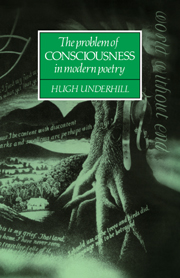Book contents
- Frontmatter
- Contents
- Preface
- Introduction: the inward revolution
- 1 From Georgian origins to ‘Romantic primitivism’: D. H. Lawrence and Robert Graves
- 2 Strangers to nature: modern nature poetry and the rural myth
- 3 The ‘poetical character’ of Edward Thomas
- 4 ‘Myself must I remake’: W. B. Yeats
- 5 ‘Here and now cease to matter’: T. S. Eliot
- 6 The work of Man: Louis MacNeice and W. H. Auden
- 7 ‘Nothing of our light’: Ted Hughes
- Conclusion
- Notes
- Select bibliography
- Index
4 - ‘Myself must I remake’: W. B. Yeats
Published online by Cambridge University Press: 18 December 2009
- Frontmatter
- Contents
- Preface
- Introduction: the inward revolution
- 1 From Georgian origins to ‘Romantic primitivism’: D. H. Lawrence and Robert Graves
- 2 Strangers to nature: modern nature poetry and the rural myth
- 3 The ‘poetical character’ of Edward Thomas
- 4 ‘Myself must I remake’: W. B. Yeats
- 5 ‘Here and now cease to matter’: T. S. Eliot
- 6 The work of Man: Louis MacNeice and W. H. Auden
- 7 ‘Nothing of our light’: Ted Hughes
- Conclusion
- Notes
- Select bibliography
- Index
Summary
The year in which Edward Thomas died at the age of 39, 1917, was the year in which W. B. Yeats, at the age of 52, married Georgie Hyde-Lees. He was a kind of elder statesman of twentieth-century poetry; it is common to say that when Pound and Eliot arrived in London and began announcing their prescriptions for a new poetic, Yeats had already made the necessary discoveries independently. He had seen the need to throw off nineteenth-century rhetoric and begun forging a poetry which could ‘come to terms with immediate experience … in a language close to common speech’. He was getting a remarkable range of experience into his poetry, bringing it under artistic control, finding it immensely difficult, yes, but not close to unmanageable in the way I've noticed in some poets. And from roughly the period of Georgian Poetry onwards he was to explore with the command of a master artist a theme of particular concern here, the plurality of consciousness.
In ‘The Chalk-Pit’ we have seen Edward Thomas conducting a dialogue between two sides of his own consciousness; ‘The Other’ is a complex interrogation of his own pursuit of an alter ego which he never quite seems able – as with all his experience – to grasp or define:
I travelled fast, in hopes I should
Outrun that other. What to do
When caught, I planned not. I pursued
To prove the likeness, and, if true,
To watch until myself I knew.
- Type
- Chapter
- Information
- The Problem of Consciousness in Modern Poetry , pp. 122 - 144Publisher: Cambridge University PressPrint publication year: 1992



